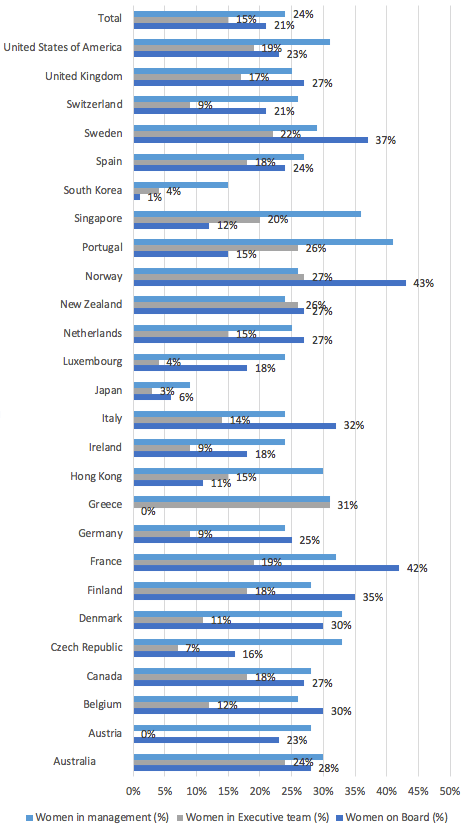Who runs the world? According to Beyonce’s 2011 smash single, girls do. Whether the world’s largest corporations have gotten the memo is still up for debate. Following a high-profile year of major companies making headlines for having corporate cultures that, to put it diplomatically, don’t value gender diversity, it’s time to take a pulse check. New York-based LeaderXXchange (which focuses on diversity, governance and sustainability and builds investment methodologies) has been tracking the planet’s 1,500 largest publicly-traded companies for more than three years. What was discovered when boardroom doors were pried open? In honour of International Women’s Day, LeaderXXchange is sharing some of its top findings with Corporate Knights’ readers.
Women rising
Walking the talk: North American diversity policies failing to deliver
As of this year, most corporations have a formal diversity policy, but that doesn’t necessarily translate into higher levels of women at the top. Case in point: 92% of North American companies have adopted diversity policies, 5% more than European firms. Meanwhile, Canadian and American companies lag behind their European and Australian peers in terms of gender diversity in leadership. It’s a clear sign that having a diversity policy is far from enough.
Target practice: Australian and European firms seeing results with gender targets
Canadian and American companies seem be reluctant to set quantifiable internal gender targets at the risk of being held accountable. Targets continue to remain a more European and Australian practice. Australia, in particular, has shown that even in the industries most traditionally perceived as male, such as mining, these targets produce results by attracting more women in the workforce with management and leadership roles.
% of women in leadership and management positions by country
Canadian corporations at the back of the global pack
To be blunt, Canada doesn’t fare well in LeaderXXchange’s global rankings conducted. First, LeaderXXchange only focuses on the largest publicly-traded companies in North America; it doesn’t rank the entire public company universe. However, it’s pretty clear from LeaderXXchange’s research that Canadian companies are more closely correlated to their American neighbors than they are to Australia (which has a similar industry base to Canada). While 93% of Canadian companies adopted gender policies, just 20.5% of board directors are women(versus 32.5 % in France). While three quarters of French companies disclose the number of women in management, only 31% of Canadian companies do (for more details on the Canadian scene read Don’t Fear the Gender Quota).
“If Canadian companies and regulators were to replicate what Australian companies have accomplished, it would rapidly move from laggard to leader,” says L’Helias. France and Australia adopted similar objectives using different strategies. France and Australia adopted similar objectives using different strategies. France adopted a 40% gender quota for boards and requires reporting on gender pay gaps, promotion gaps and more. Australia adopted the “comply or explain” model.
Changing board rooms, lagging C-suite
It’s become clear that having diversity in leadership and management is critical to attracting and retaining talent – as well as investors. Institutional investors have actually been the driving force behind gender shifts in boardrooms, particularly in Canada and the US. In fact, gender diversity on boards has become the leading issue investors want directors to address, alongside executive compensation and climate change. To hincentivize laggards, several large institutional investors, including New York’s State Comptroller, have adopted strict voting guidelines to vote against nominating committee members of boards that have no women. It’s no wonder that as the proxy season approaches, a number of highly visible companies – particularly in the tech sector – have added women on their boards.
The diversity advantage: Studies are revealing that diverse groups make better decisions. Researchers are finding that diversity brings a level of complexity to the decision-making process that reduces blind-spots and increases the probability of better identifying and assessing risks and opportunities.
Regardless of progress at the board level, the glaring reality is that the world’s largest corporations are stalled in second gear when it comes to hiring women in C-suite leadership roles. Top senior executive officers with the letter C in their title (CEO, CFO, CIO, COO, CSO) lag behind on gender in all markets.
It’s a problem that’s not going to fix itself. Says L’Helias, “Companies need to expand their efforts to fix the leakage in the gender leadership pipeline if they aim to close the gender gap in those critical roles.”
Average % of women in leadership and management positions by region
Some sectors are leading the way
Sectors can and do change. Once a notorious “boys club,” the financial sector now has the largest number of companies that outperform LeaderXXchange’s median score. What gave? For one, L’Helias points out that the 2008 financial crisis created a crisis of confidence. Investors and regulators used their new leverage to focus on improving the industry’s governance, particularly the banking industry. Employees and clients were also adding pressure.
After massive layoffs, the sector had became less attractive to young recruits. Moreover, clients (institutional retail and high net worth) voiced their concern about the lack of gender diversity. Finally, in the United States in particular, the financial industry was subject to a number of class action lawsuits for racial and gender discrimination.
Number of companies performing above the global average
by sector
Percentage of companies performing above the global average
Nonetheless, while the financial industry has made great strides, and exceeds the median score, few financial institutions land in the top 50. That’s because there is significant room for progress for the C-Suite.
Notably, utilities and manufacturing have also statistically outperformed LeaderXXchange’s median grade. The sectors are fighting to attract and retain talent at a time of intense competition and new disruptive technologies.
“By creating cultures that are more inclusive and closing the gender gap, these industries are signaling to female candidates, who may not have thought of working in these sectors, that they are welcome,” says L’Helias.
“Perhaps that is what the data is telling us: companies that want or need the change – make the change.”
The LeaderXXchange Gender Diversity in Leadership ranking uses a proprietary methodology created by Sophie L’Helias, President of LeaderXXchange, an international corporate governance expert, experienced board director, former managing director of an activist hedge fund and international M&A attorney in New York and Paris.
LeaderXXchange is a change-driven organization that promotes diversity and sustainability in governance and leadership with investment methodologies and other solutions – most recently the Gender Diversity Exchange, the award-winning search engine dedicated to Gender Diversity in leadership.
The proprietary data used for the ranking is provided by Vigeo-Eiris, a global provider of environmental, social and governance (ESG) research to investors and companies. Based in Paris, with offices around the world, the Vigeo-Eiris team is composed of a diverse team of more than 200 experts from 28 countries dedicated to bringing high quality data.











